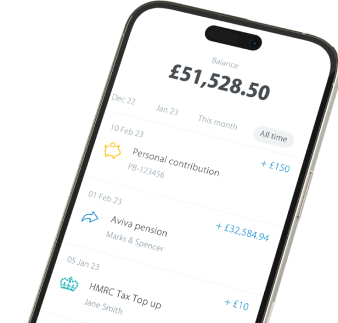When you’re self-employed it can be easy to neglect your pension, especially without a workplace pension to compel you to save. Building a pension pot can also be difficult if you don’t receive a regular income, but there’s lots you can do to plan for your retirement and save flexibly.
You can set up a private pension that lets you make self-employed pension contributions sporadically, whenever you have the funds. For 2025/26, you can contribute up to £60,000 to your pension each year and can carry forward any unused allowances from the previous three years, as long as you were a member of a pension in those years.
One of the best things about setting up a self-employed pension is that you’re eligible to receive tax relief on your contributions from the government. The standard amount of tax relief is a 25% tax top up for basic rate taxpayers, meaning that if you put £100 into your pension pot, HMRC effectively adds another £25. If you pay a higher rate of tax, you’ll be able to reclaim additional tax relief through your tax return.
The types of pension for the self-employed
There isn’t only one pension for the self-employed, which gives you the freedom to choose the best pension options for your needs.
There are three main types of self-employed pension to choose from:
- Ordinary personal pensions - the most common option and are offered by most providers.
- A Self-Invested Personal Pension or (SIPP) - a pension that you manage yourself. You can choose from a wide range of assets to invest in, from stocks and shares to commercial property and trusts.
- A stakeholder pension scheme - has a minimum gross contribution of £20 and fees are capped at 1.5% a year, for the first 10 years. It allows you to save flexibility, and you can stop and start your payments without incurring a penalty.
Another option is the NEST (National Employment Savings Trust) government scheme, which was originally setup as a low-cost workplace pension scheme. You can join if you’re self-employed or the sole director of a company that doesn’t employ anyone else.
Pension tips for the self-employed

Don’t neglect your National Insurance contributions (NICs)
In the same way that you have to manage your own taxes, you’re also responsible for paying your National Insurance (NI). Self-employed National Insurance contributions (NICs) are counted towards your State Pension entitlement and you need to have at least 10 years of NICs on your record to receive the new State Pension. To qualify for the full new State Pension of £230.25 a week (2025/26) you’ll need 35 years of self-employed National Insurance contributions.
Set a retirement goal
If you need some help with your retirement planning, the PensionBee Pension Calculator can help you set a retirement goal and calculate how much you’ll need to save. You can input the age you’d like to retire, your current age and details of any savings you already have. There’ll be an option to exclude employer contributions so you can see exactly how much you’ll need to save each month to reach your target.
Transfer your old pensions into your new pension
If you’ve been a member of a workplace pension in the past it’s likely you’ll have an old pension with a different provider. Transferring any old pensions into your new one can make your savings easier to manage and you’ll only have one fee to pay. The Pension Tracing Service can help you track down any pensions you’ve lost track of, and if you choose to move your pensions to a PensionBee plan, we can help you transfer and combine your pensions.
Start saving today
Whether you’ve just started working for someone on a self-employed basis, are self-employed but working for an employer regularly, or have been working for yourself for decades, it’s important to set up a self-employed pension sooner rather than later. The earlier you start saving the more time your pension will have to grow - plus you can keep contributing regardless of how your employment changes in the future.

Opening a PensionBee pension
The PensionBee plans are personal pensions that are open to employed or self-employed people. Like all personal pensions, they’re defined contribution pensions, which means the amount you have when you retire depends on the amount paid in and the performance of your investments.
PensionBee’s pensions for the self-employed have some great benefits:
- they can be managed online or using the secure PensionBee app;
- you can set up regular contributions or add one-off payments; and
- there’s just one simple annual fee.
If you’ve never saved into a pension before, you can start one with PensionBee without having an existing pension.
Risk warning
As always with investments, your capital is at risk. The value of your investment can go down as well as up, and you may get back less than you invest. This information should not be regarded as financial advice.
Last edited: 07-07-2024





